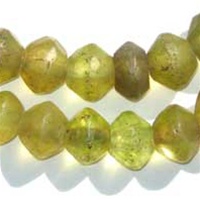Vaseline Trade Beads: A Radioactive Discovery?
We are proud to share with you the most comprehensive background on those beautiful beads known as Vaseline trade beads.
The 'radioactive era' as some refer to it was a period between the early
1900's, up to 1930 when a number of distinctive discoveries and advancements influenced an obsession with all things 'radioactive'. It was German chemist Martin Heinrich Klaproth who first discovered Uranium in 1789, however later revelations from French physicist Antoine Becquerel in 1896 proved that Klaproth had not isolated the metallic element - which we now know influences color under ultraviolet light.
Marie and Pierre Curie's work superseded these scientific announcements with the pioneering discovery of Radium in 1898. Interestingly, Marie Curie's work which extended to developing x-ray technology and radiography, won her two Nobel Prize Awards. Her work assisted in helping the treatment of soldiers during World War I, which is probably why she was also the first prize winner to be award two consecutive prizes, for two different types of work - chemistry and physics.
The trend for radioactive chemicals being used for decorative and everyday objects began around 1905. Everything from blown glass vases, to clock-faces, earthenware, pottery and Vaseline Beads were being made with the fluorescing properties of Uranium. Uranium influences an intense yellow-green, or violent green depending upon the kind of light it is subjected to, and appears to glow immensely in ultraviolet light.
Prior to the official discovery of Uranium as an isolated element, the compound was already being used (it is thought) within the production of glass trade beads. Several collections of faceted Vaseline Beads have been discovered, and are thought to date back to the 1830's - all feature the yellow-green characteristics attributed to the Vaseline Beads of the early 1900's. Vaseline Beads are often regarded as a product of Africa, however were first produced within Bohemia - now Czechoslovakia.
The fascination with radioactivity between 1905 and 1915 prompted a period of mass production for Vaseline Trade Beads, and not just within Bohemia. Several other countries, including England and Italy were also caught up with the fascinating properties Uranium salts influenced. Interestingly, it was only a concentration of 1-2% Uranium salts to a glass mold that would offset the chemical reaction that produces the green-yellow aesthetic.
Authentic Vaseline Beads produced around the late 1800's/ early 1900's are distinct due to their shape. Rondelles and discs were by far the most common shapes, however it is not unusual to uncover some with cut facets. Later replicas of Vaseline Beads were produced without Uranium (since later science also uncovered the possible harmful effects of radiation), and can be found in multiple hues. The Uranium was replaced with oxides or dyes during the molding process, and manual manipulation used to replicate the fluorescing qualities of Uranium.

Leave a comment